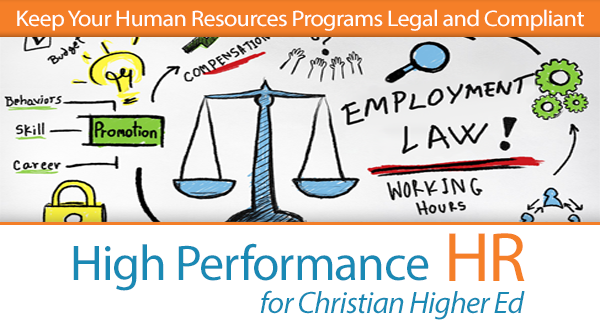
Mar 6, 2018
Are you complying with all the proper state and federal labor laws? If not, it could cost you everything.
Christian Higher Education is not immune from compliance. And compliance is very important. In our opinion Christian Higher Education may even be more susceptible to investigation then other organizations.
In large organizations, an entire human resources (HR) department navigates the complex minefield of federal and state labor laws. Some small organizations (under 100 employees) think of HR as an afterthought, or HR responsibilities like hiring, benefits, compliance, and payroll falls to a few people who aren’t properly trained. This can be a pricey mistake. Laws concerning overtime, unlawful termination, and equal rights are just a few areas that trip up organizations, big and small, all the time.
Labor laws fill volumes and are quite complex. Plus, labor laws vary from state to state! Even Walmart ran into trouble recently and incurred $4.83 million dollars in back wages, penalties, and fines for violating The Fair Labor Standards Act. The mistake? Managers were misclassified and not appropriately compensated for overtime work. Unlawful termination is another problem that has cost organizations like UPS, Carmike Cinemas, and Dial Corporation dearly. Yes, it’s tricky. Do you know the laws?
It gets worse—the government is ramping up efforts to check up on organizations and crack down. The Obama administration in 2017 allotted $25 million for the sole purpose of investigating those misclassified as “independent contractors,” hoping to reclaim alleged lost tax revenue and increase the IRS’s revenue. Be smart. Remember that stiff penalties and lawyer fees can decimate your organization. Are your workers properly classified?
Stay legal and remember these 3 key points:
- Child labor, non-resident labor, and equal rights legislation are the three areas where many organizations most often fail to comply.
- Both state and federal labor information is free and available online.
- Outsourcing with an HR professional firm can save your organization a lot of time and money.
Most organizations with fewer than 100 people benefit from outsourcing labor law compliance and other human resource tasks to HR professionals. The alternative is risky: employees are often uninformed about and under-trained in labor law compliance. Look out! Federal fines could be in store for you. In addition, HR often falls outside an employee’s main job focus, so getting it wrong or spending valuable time away from primary tasks can cripple productivity in a small organization. Get the right person trained or on your team to comply with labor laws.
Regrettably, staying legal has never been more difficult or important.
Make 2018 your organization’s best year ever. Make sure to get the Human Resources help you need right away.
_______
In His Name HR helps organizations build high performance Human Resources programs. Visit them at In HIS Name HR or e-mail them here.
Mark A. Griffin is the founder and chief consultant of In His Name HR LLC. Connect with him on LinkedIn or Twitter.

Mark A. Griffin | Christian Higher Ed HR
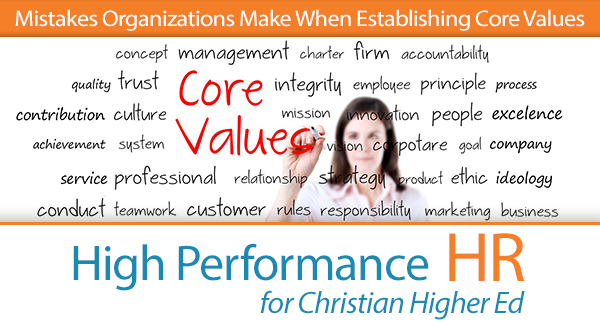
Feb 27, 2018
Today, we build on the two previous posts, on creating Mission and Vision Statements by discussing Core Values and creating your organization’s Value Statement, which completes the triad.
When organizations desire to perform at the highest level, they leverage three (3) commitments—three commitments that set the stage for overall efficiency, growth, and prosperity.
Core Values focus on how you run your organization and interact with customers and suppliers. Not everyone possesses the same core values, so it’s important for an organization to stress what theirs are to employees, vendors, and customers at the onset of hiring, doing business, or providing a service.
Take this example: Facebook started out in a dorm room and, in just ten years, grew to having 1.23 billion monthly users, about one-sixth of the entire world’s population. To celebrate that accomplishment, Mark Zuckerberg expressed how a Core Value guided them along the way:
“…We just cared more about connecting the world than anyone else. And we still do today.”
With its expressed Value of caring, Facebook is guided toward their vision and mission of accomplishing bigger and more important goals. It is yet to be seen whether Facebook will be foiled by one of the 5 very common mistakes we are about to explore here.
Mistake # 1: Being too vague
Your Core Values should be both meaningful and easy to understand. So, if caring is a core value, what does “caring” really mean? Your Value statement should flesh this out in a simple and powerful way. Zuckerberg outlined his 5 Core Values as “The Hacker Way.”
Mistake # 2: Lack of accountability
Your Core Values must be built into your performance management process or the oversight to ensure success will be sorely absent.
Mistake # 3: Creating too many Values
By limiting this list to reflect only your highest priorities, your core Values will be focused and accountability will increase.
It’s tempting to make a long list of Values that you think are important; however, when you keep the number to about three or four key items, you make enacting them easier and more likely.
Mistake # 4: Failing to share core Values with prospective employees
Potential employees should know how things work and what it’s like at your organization from the start. When someone does not subscribe to your Values, don’t hire them.
Mistake # 5: Not including a core Values preface statement
Some core Values can end up seeming disingenuous or hypocritical once mistakes are made. The best way to inoculate your organization from this is to disclose that possibility up front.
Include a preface statement like this:
“Although we strive for perfection, we sometimes miss the mark. When we do, we apologize and work to improve as we move forward. The following is a list of the values we strive to maintain.”
Your students, instructors, vendors, customers, and employees will appreciate your honesty and be more likely to give you the benefit of the doubt, should problems arise.
Core Value Statements are crucial to the culture of your organization and shouldn’t be taken lightly. The best way to ensure that your trio of Mission, Vision, and Value Statements will succeed is to ensure they are integrated into all you do from an HR perspective.
By avoiding the common mistakes and using top-notch methods, you’ll ensure that employees can achieve your Mission and Vision by adhering to the core Values most important to your organization. A high-performing organization is one that can last and even thrive in tough economic times. It must by guided carefully using processes that ensure consistency and stability through the Values you hold most dear.
___________
In His Name HR helps organizations build high performance Human Resources programs. Visit them at In HIS Name HR or e-mail them here.
Mark A. Griffin is the founder and chief consultant of In His Name HR LLC. Connect with him on LinkedIn or Twitter.
Mark A. Griffin | Christian Higher Ed HR

Jan 22, 2018
ABHE Annual Meeting
February 21-23, 2018 | Rosen Plaza Hotel, Orlando Florida
Right-sizing – an organizational lifesaver . . . or toxic solution to financial difficulties? But when layoffs are not well thought out and used repeatedly without a graceful strategy, right sizing can destroy an organization’s effectiveness. How you treat people really matters – to the people who leave and perhaps most critically, to the people who remain.
• Taking steps – simple, impactful, and timely to make the process gracefully effective
• Executing a comprehensive communication plan – to students, faculty, employees, alumni and community
• Supporting displaced employees
• Caring for employees who remain
• Avoiding common pitfalls observed in other organizations
Learn More Here
Visit us- Booth 119 – ABHE Annual Meeting!
About the Speaker
Mark A. Griffin is the founder and chief consultant of In HIS Name HR LLC, a human resources outsourcing and career coaching firm created to help organizations pilot the complex issues of managing HR.
As a human resources professional with 20-plus years of experience in both public (Quaker Oats Company, Kodak Inc., Merck Inc.) and private companies (Woolrich, Conestoga Wood Specialties, Valco Companies Inc.), Mark is passionate about building high-performance workplaces by utilizing best practices while leading organizations with strong values.
Mark and his wife Gail have two adult children, and and attend LCBC Church. Mark has coached leaders on “Business as Mission” as far away as Eastern Europe, India, Haiti, Honduras, Nicaragua and the Dominican Republic.
Speaker, accomplished HR consultant, and the author of How to Build “Kingdom-Minded” Organizations and College to Career: The Student Guide to Career and Life Navigation, Mark A. Griffin encourages leaders to build values-led organizations during these increasingly complex times.
Mark A. Griffin | Blog, Christian Higher Ed HR, Events

Jan 17, 2018
Today, we’ll look at the 3 biggest mistakes commonly made by organizations during the creation of their Vision Statement.
As discussed in the last post, Organizations wanting to perform at the highest level do so by working to leverage 3 commitments. These commitments set the stage for overall efficiency, growth, and prosperity.
Mission Statement
Vision Statement
Core Values
Great leaders vision-cast for their organization.
They have an idea of where they want their organization to be down the road. They chart their desired course ahead of time. The best leaders will map out their Vision, put this Vision on paper, and share their Vision with the entire crew. However, too many leaders fail to be precise—they don’t follow a top-notch process to ensure their Vision truly comes to fruition.
Mistakes You Want to Avoid
Mistake #1: Developing a Vision Statement that isn’t achievable in the near future—within an employee’s working lifetime.
This is a bad idea. Instead of a far-off Vision as the organizational aim, your employees need to envision achieving the goal far sooner, so they can potentially experience the achievement as part of the team.
No employee wants to think that they are expected to work hard to achieve an organization’s Vision without still being around to celebrate it happening. If the goal lies too far into the future, employees don’t feel invested in the outcome. They don’t feel committed to it. Instead, it gets shelved and ignored. With an achievable goal, hope, motivation, and perseverance are ignited. They can see your destination on the horizon. Your excitement will become theirs.
When creating a Vision statement, make it achievable. Once it’s achieved, make sure you revisit it and make any adjustments and corrections to it as you move forward.
Mistake #2: The Vision statement is not included in the hiring and recruitment processes.
As you build your team, make sure that your potential employees know the direction your organization is headed; starting the moment they first step through the door. Let them know where they’re going when they first get onboard. It’s not enough to expect them to figure it out by osmosis. Don’t leave your Vision to chance. Tell them up front what it is and the role they will play in achieving it.
Your Vision statement must be seamlessly incorporated into your hiring practices and documents. If it is not obvious from the start, you risk spending a lot of time, energy, and money acquiring people who don’t know where you’re going and don’t care. Your organization will be rudderless.
Your Vision Statement is an invaluable motivator for your employees. Would you want to board a ship or a plane without knowing the destination ahead of time? Your employees won’t want to either.
As a leader, you are the captain. Your crew—your employees—and your passengers—your customers—must be informed as to the destination of your journey and be enthusiastic about it.
This is how high performance gets started!
Mistake # 3: Failing to integrate your commitment to your organization’s Core Values and Mission Statement into your Vision Statement—not making it a complete, holistic package.
A Vision statement should articulate two crucial items in addition to your Vision: your Mission statement and the core Values guiding your organization.
These three components are interdependent and must work together as a team. Just like a top coach wouldn’t play merely one-third of his football squad in the Super Bowl, it is not possible to create a high-performing organization from the ground up if it lacks any of these three key components.
The success of your Vision is important to your future—much too important to omit any of the key supporting pieces and risk it failing.
If creating these three documents sounds like a lot to bite off, don’t be discouraged! Human Resources experts exist to help you, and resources exist to make it easier. The best ones guide you through the whole process, just like the one I created with my team. We’ve done the foundational work for you to make it all happen smoothly and simply. Our HR Mastery Toolkit teaches and guides you to implement the best practices used by some of the top, most successful organizations in the world.
We begin with this essential first task: establishing your organization’s Mission, Vision, and Values.
By using a top-notch process to create your Vision Statement, you’ll set the stage for your employees to achieve it.
In the next post, we will continue examining this critical trio. I’ll give you some of the expertise I’ve gleaned from more than twenty years in the field of human resources. Come back to read: Mistakes Organizations Make When Determining Their Core Values.
___________
Join us at the 2018 Annual ABACC Conference at the Wyndham Orlando Florida Resort (International Drive). We will be exhibiting at this informative conference February 13 through February 16, 2018. Learn more here.
We will also be speaking (Grace and Wisdom When Right-Sizing Your Staff) and exhibiting for the ABHE Annual Meeting February 21-23, 2018 at the Rosen Plaza Hotel, Orlando Florida Learn more here.
Contact us directly to set up a personal meeting in advance of the annual meeting. Looking forward to creating new friends and fostering deeper relationships with contacts we know.
In His Name HR helps organizations build high performance Human Resources programs. Visit them at In HIS Name HR or e-mail them here.
Mark A. Griffin is the founder and chief consultant of In His Name HR LLC. Connect with him on LinkedIn or Twitter.
Mark A. Griffin | Christian Higher Ed HR
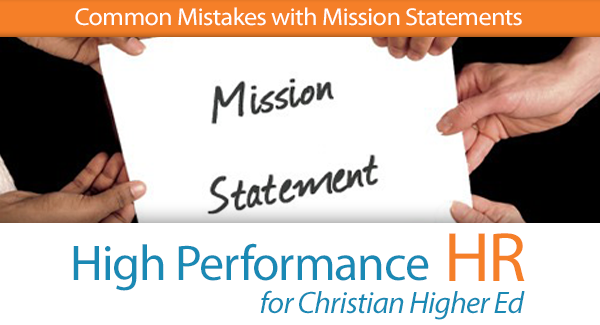
Jan 9, 2018
When organizations want to perform at the highest level, they leverage the three (3) commitments that strengthen their organization like a strong, cement foundation:
Mission Statement
Vision Statement
Core Values
With these in place, everyone in the organization starts out on the same page. Better yet, clients and customers know what to expect and it builds additional trust. They appreciate the organization’s investment and articulation of these commitments.
However, it’s not as simple as punching out three sentences to propel your organization forward. There is an important process to creating potent organizational statements to ensure they truly succeed.
Today, we’ll look at the 4 mistakes commonly made during the creation of an organization’s Mission Statement. Done poorly, a Mission Statement can actually undermine the high performance leadership hopes to attain in the first place.
Don’t let this happen to you!
Mistake #1: Not including employees in the process.
When leadership creates a Mission Statement in a vacuum, employees are far less likely to appreciate it, accept it, and, most importantly, execute it.
Instead, your organization should first get input from a group of employees that make up a good cross-section of capabilities and responsibilities throughout the organization.
At this point, too many organizations find that employees have little idea what their organization really stands for or why they are doing what they do. Unless you’ve clearly articulated a Mission Statement, you can’t blame them. After employee input, the leadership can approve and improve on what comes from the employee input group.
With a Mission Statement in place, employees do more than just show up. They arrive to work with a renewed orientation to the organization and feel like they are doing something meaningful. Everyone wants to play a part in something bigger than just themselves. A Mission Statement gives them this opportunity.
By including them from the start, employees not only start to think from a high-performing standpoint, but they also feel respected and appreciated for their input at the outset.
Mistake #2: Creating a Mission that is too broad or too lofty.
Here are examples of two Mission statements that don’t work:
“We want to make the world a better place.”
“We want to give our customers good service and a great price.”
Compare them to one from Charity Water. It gets to the crux of their mission.
“We’re a non-profit organization on a mission to bring clean and safe drinking water to every person on the planet.”
Or, this great example from Habitat for Humanity International:
“Seeking to put God’s love into action, Habitat for Humanity brings people together to build homes, communities and hope.”
Mistake #3: Not rolling out the new Mission appropriately.
A good Mission Statement is woven into the very culture and fabric of your organization. It’s not just something that goes on the wall and the website. It gets incorporated into all the material of your organization.
During your hiring practices, organizational meetings, performance reviews, and in job descriptions, you should have direct tie-ins and references to your Mission. After all, your organization is centered on a Mission: its purpose for existing.
EXPERT TIP: Your employees are great idea factories to help find new ways to proliferate and enact your organization’s Mission statement in multiple ways that will make a big difference. Get their input.
Mistake #4: Not communicating the Mission to your key stakeholders.
Your key stakeholders are your students, parents, vendors, and suppliers. Your Mission statement should be integrated into your interaction with them, and in all the material, marketing, and communications you engage in together.
Your Mission Statement is the central feature around which your organization revolves. That means, it’s not just an internal document. Make sure you publicize it, every chance you get.
You don’t have to tackle the process of creating a Mission Statement alone. You can hire an outside HR expert to guide you. There are other helpful HR resources too, like the HR Mastery Toolkit we have created to make your organization high-performing in this and other areas. It teaches and guides you in the best practices of some of the top, most effective organizations in the world.
When you create a Mission Statement using a top-notch process, you’ll find that performance on every level improves. Not only do you save costs and improve quality and productivity, but also being employed at your organization becomes much more enjoyable.
In our next post, we will continue examining this critical trio. I’ll give you some of the expertise I’ve gleaned from more than twenty years in the field of human resources. Come back to read: 3 Mistakes in High-Performance Vision Statements
___________
In His Name HR helps organizations build high performance Human Resources programs. Visit them at In HIS Name HR or e-mail them here.
Mark A. Griffin is the founder and chief consultant of In His Name HR LLC. Connect with him on LinkedIn or Twitter.
Mark A. Griffin | Christian Higher Ed HR

Nov 27, 2017
Finding and keeping qualified talent has never been more challenging or expensive. Too many organizations implement haphazard hiring methods that are not only inefficient, but also potentially illegal.
Are people hired systematically at your organization?
The best organizations in the world use sophisticated processes to find and hire new workers. If you don’t have a solid system in place to hire workers, consider creating policies, and putting them in writing, that outline your process in detail.
Ready to get started?
Here is a checklist of 4 action steps that you should ensure your HR department is following. By using these steps they will simplify the hiring process for your organization.
Step 1 – Create a candidate pool by…
- Constructing a comprehensive job description (with employee input)
- Having leadership approve the position and salary range (based on a compensation study)
- Posting the position internally first, to allow current employees the opportunity to apply
- Encouraging employees to refer friends and family
- Creating an advertisement based on the established job description
- Running the advertisement
- Reviewing ad responses against the requirements outlined in the job description
- Sharing your Mission, Vision and Values (MVV) with all candidates
- Having the candidates explain how they will support your MVV
- Setting up three to four candidates for interviews
Step 2 – Systemize the interview process by…
- Selecting interview questions and job criteria correlated to the job description requirements (build MVV questions into process)
- Requesting all interviewees first fill out an application
- Ensuring all interviewees sign a “consent to background check” form
- Having interviewers complete a Candidate Evaluation Form on every candidate after each interview.
Step 3 – Establish the Selection Process by…
- Having the team of interviewers meet to discuss candidates (this is typically led by HR personnel)
- Conducting candidate interest testing (be careful with tool used)
- Selecting the best candidate based on interview results, selection testing, and the hiring manager’s decision
- Furnishing a verbal offer to the candidate and, if agreed to, creating an offer letter
- Sending the offer letter for the candidate to sign, and ensuring it is returned to you.
Step 4 – Start the hiring process by…
- Sending the application and consent form to a background check company
- Arranging a pre-employment physical and drug & alcohol test for the candidate
- Setting a firm start date when the candidate has met all the requirements and is determined “all clear”
- If the candidate fails the background or D&A test, the candidate is notified by HR and you return to initial pool of interviewed candidates, choose one, and begin the hiring process again or expand the candidate pool and begin again.
- Sending out polite non-selection letters to the other candidates
When you implement a consistent system in your hiring practices, you will increase the efficiency of your organization, saving time and money, and eliminating confusion, both now and in the future.
Also consider the fact that by using the right recruitment approach you are also marketing your organization to potential students?
Any dollars spent in recruitment marketing also benefits your institution from a brand recognition perspective.
___________
In His Name HR helps organizations build high performance Human Resources programs. Visit them at In HIS Name HR or e-mail them here.
Mark A. Griffin is the founder and chief consultant of In His Name HR LLC. Connect with him on LinkedIn or Twitter.
Mark A. Griffin | Christian Higher Ed HR
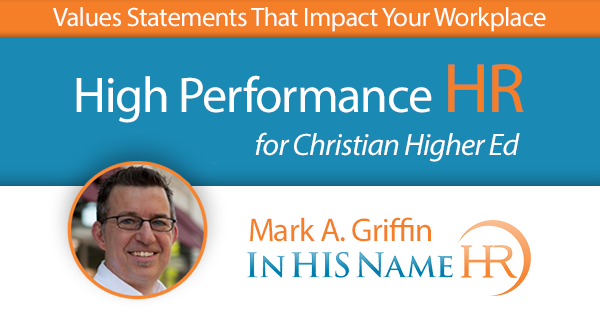
Oct 3, 2017
The third ingredient of MVVs is values, specifically core values. A core value, from a human resources perspective, reflects the heart of an organization. It pumps the blood throughout; it makes an organization tick. It defines the organization and its culture and what it takes pride in doing. It is how vendors and customers view an organization’s behavior toward them. It is what employees tell their neighbors and friends when asked what it is like to work where they do. It is why your students choose your college. It is the behaviors your staff and instructors exhibit as they
In the secular world an organization focused on quality might state its core value as: We do not compromise on quality. Quality is job one. An organization valuing individual responsibility would want to say: We believe in holding ourselves accountable. We deliver on our promises and we always endeavor to use good judgment. Efficiency, honesty, customer service, ownership—these and many more reflect the kinds of core values that high-performing organizations embody.
In order to enjoy growth and prosperity and achieve high performance, an organization must first look inward and thoughtfully address these three critical aspects of running an organization. Those that invest in a well-developed and bought-in mission, vision, and values will reap dividends far beyond those that do not.
As leaders at Christian colleges and Universities, we take a Biblical/Kingdom approach to our Mission, Vision and Values creation. Often times it is best to cite a bible verse to stir commitment and affirmation as to why the value is important.
In doing research we discovered Ozark Christian College’s Values Statement. Enjoy reviewing and reflecting how your Values statement might be updated or recast to create excitement on your campus.
CORE VALUES
THE WORD OF CHRIST TAUGHT IN THE SPIRIT OF CHRIST (COLOSSIANS 1:28)
We believe the Bible is the true and authoritative Word of God and our final rule of faith and practice. We want to teach God’s Word faithfully, in harmony with God’s Spirit.
NOT TO BE SERVED BUT TO SERVE (MARK 10:45)
We are a servant of the church, training vocational and volunteer servant leaders for the worldwide work of ministry. It is the commitment of teachers, staff and students that we will love and serve others.
SPEAKING THE TRUTH IN LOVE (EPHESIANS 4:15)
We want to honor God by fulfilling our personal responsibility to be honest and caring with one another.
TRUSTING IN THE POWER OF GOD AND SEEKING THE GLORY OF GOD (1 CORINTHIANS 4:20 & ISAIAH 42:8)
We are absolutely and utterly dependent upon God. The work is too great for human resources. We pursue excellence, knowing all glory is God’s and any accomplishment is of him.
ATMOSPHERE OF GRACE, TRUST AND FREEDOM (ROMANS 15:7 & 1 PETER 4:10)
We accept one another as imperfect people saved by the grace of God. Mutual trust, based on our commitment to the Lord, guides our relationships. We desire each person to have freedom to develop God-given gifts.
RESTORING BIBLICAL CHRISTIANITY (JOHN 17:21)
We are committed to teaching and practicing biblical Christianity, believing it is central to unity among believers and evangelization of the world.
WORSHIP IN SPIRIT AND TRUTH (JOHN 4:23-24)
We foster spiritual health through genuine worship, both personal and public. Worship is for the glory of God, exhortation from his Word, and edification of the community of faith.
___________
In His Name HR helps organizations build high performance Human Resources programs. Visit them at In HIS Name HR or e-mail them here.
Mark A. Griffin is the founder and chief consultant of In His Name HR LLC. Connect with him on LinkedIn or Twitter.
Mark A. Griffin | Christian Higher Ed HR
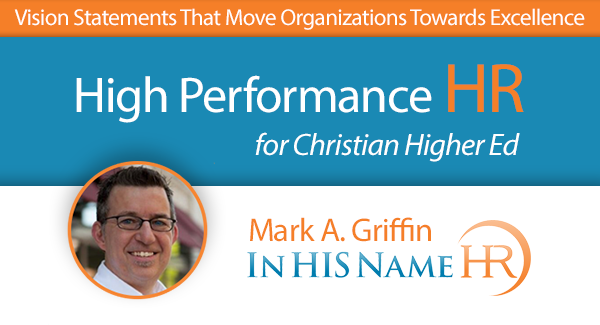
Sep 20, 2017
Vision statements should consider how the market and your customer base may change within the next three, five, or seven years, how such changes can create opportunities for your organization, how to bridge the distance between how things are today and where you envision you want to be within your established timeframe, how you will surpass your competitors in order to gain greater market share, and also what you are doing collectively to capitalize on the changes in business conditions and your business’s needs.
Like a mission, an organization’s vision has ideally been created/ contributed to by all employees. The more buy-in an organization has among its employees, the greater the effectiveness of the vision. The vision should inspire—it demonstrates where the organization as a whole wants to be, and what will occur as it delivers on its mission. It is where an organization envisions itself in those three, five, or seven years. (We prefer five years, because that is a reasonable amount of time for most organizations to get to the next step.)
So, whereas the mission is what an organization does best every day, its vision is what the future looks like when it fulfills its mission exceedingly well. Some effective vision statements include Nike: To be the number one athletic company in the world, and Amazon: Our vision is to be earth’s most customer-centric company; to build a place where people can come to find and discover anything they might want to buy online.
When I worked for Gatorade, we developed an incredible advantage over the competition because we took the time to establish its vision, where they were going and when they wanted to get there, and ensured that every employee shared this vision. Gatorade’s competitors at the time, Powerade and All Sport, faded away as a result, because they lacked a commonly shared vision, they lacked direction—they lacked a road map.
___________
In His Name HR helps organizations build high performance Human Resources programs. Visit them at In HIS Name HR or e-mail them here.
Mark A. Griffin is the founder and chief consultant of In His Name HR LLC. Connect with him on LinkedIn or Twitter.
Mark A. Griffin | Christian Higher Ed HR
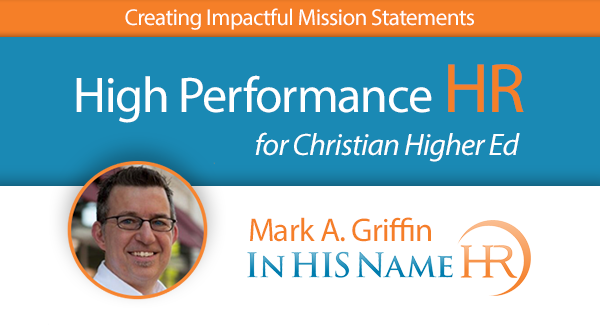
Sep 5, 2017
Successful organizations begin by establishing their mission, which is the core reason for their existence—the product or service they provide, who they provide it to, and the benefits of that product or service. A lack of an established mission means that not only are staff and management unsure of their purpose, but customers and vendors are also left in the dark, uncertain of what to expect.
An organization’s mission ideally defines what it does best every day and why, and reflects the customer’s needs as well. Having a mission is the foundation upon which a high-performing organization’s dreams and potential become reality. Essentially, it affirms the reason(s) why an organization exists.
Under the guidance of a project facilitator, a team of senior management begins by developing a framework of what they believe the mission should be. The facilitator shares and explains this mission framework to each supervisory layer, soliciting input on each occasion, and ultimately shares it with the employees who then sit down with a good human resources representative in a roundtable session to discuss it and generate further input. The facilitator may need to go back and forth a few times before a final product is derived. Once the majority of employees and management agree to the refined mission, all employees need to agree to respect and support it.
A primary benefit to creating or revisiting a mission is that it opens up communication within and throughout an organization. Every successful organization has a clearly established mission, one that has been developed with input from all employees collectively, not simply flowing down from the top. By engaging employees in establishing their organization’s mission, they become fully invested in it. The mission must be ingrained within the organization’s culture. Not only are employees and customers made familiar with the organization’s mission; candidates are also exposed to the mission of high-performing organizations during the interview process, before they’re offered a position.
Some tips to remember when writing a mission statement: 1) keep it short and easy to remember; 2) specify who your target customer is and describe the advantages you offer; and 3) define your product clearly and how it differs from the competition.
You may be wondering how you can say all that and still keep your mission statement short and memorable. Here are two strong examples from high-performing organizations with effective mission statements.
Google: We organize the world‘s information and make it universally accessible and useful. Their marketplace? The world. Their product and its advantages? Organizing the world’s information to make it easily accessible and useful. They do this and they do it exceedingly well.
Starbucks: We inspire and nurture the human spirit — one person, one cup, and one neighborhood at a time. Their marketplace? Also, essentially the world, yet they stress the individual: one person, one neighborhood at a time to maintain a personal feel. We are already very familiar with their product and social coffeehouse environment, aren’t we?
Let’s look at a Bible College and Seminary Mission.
Lancaster Bible College|Capital Seminary & Graduate School: Our focus is on your journey to fulfill God’s purpose for your life. Our mission has remained constant since 1933: To educate Christian students to think and live a biblical worldview and to proclaim Christ by serving Him in the Church and society.
And finally a Private Christian College.
Messiah College: Our mission is to educate men and women toward maturity of intellect, character and Christian faith in preparation for lives of service, leadership and reconciliation in church and society.
In addition to a mission statement, all high-performing organizations possess a clearly defined vision. Organizations with an established vision have a workplace of direction, purpose, and achievement. These organizations envision where they want to be and do the appropriate things to get there. Every employee is given a copy of this road map.
In His Name HR helps organizations build high performance Human Resources programs. Visit them at In HIS Name HR or e-mail them here.
Mark A. Griffin is the founder and chief consultant of In His Name HR LLC. Connect with him on LinkedIn or Twitter.
Mark A. Griffin | Christian Higher Ed HR

Aug 21, 2017
When we meet with people to discuss strengthening their HR practices, we often use the term “Kingdom-minded organization.” More often than not, they are intrigued as to precisely how we define what potentially encompasses a considerably broad scope or approach. Certainly, many Christian business people, academia professionals, pastors, and consultants have their own ideas as to what constitutes a Kingdom-minded organization. My own Kingdom-minded human resources organization has worked hard to develop what we feel is a clear, actionable, and measurable articulation of just what a Kingdom-minded organization means to us and how to achieve it, and, as a result, the organizational leaders we work with express enthusiasm to achieve these goals, and are willing to invest their precious time, dollars, and energy into making their organization a prosperous one, and one reflective of Christ and His teachings.
In terms of what comprises the framework of a Kingdom-minded organization, the model I developed contains principles that apply to marketplace organizations, colleges and universities, churches, and non-profit organizations alike.
A Kingdom-minded organization puts Christ first, with a focus on integrity, honesty, and straightforward dealings with students, alumni, parents, staff, contractors and suppliers, etc. Such an organization possesses clearly delineated mission, vision, and core value statements. It has agreed upon goals and objectives, especially in the realms of mission execution, customer service, production, and quality.
Being a Kingdom-minded organization does not in any way preclude prosperity. On the contrary, it aims to be prosperous for the benefit of its key stakeholders, leadership, owners, employees, and the organization’s community. They should—they must—strive to do great things, marrying their godly goals with the fruits of success, those of a job well done. By no means should they consider themselves as unable to participate in the results-driven culture of winning U.S. organizations.
Mission, Vision, And Values (MVV)
When mapping out the future of an organization that professes to strive to become high performing, management must create its mission, vision, and value statements (MVVs) or ignite existing ones by recreating them. Much has been written on what should comprise mission, vision, and value statements. I always suggest keeping them simple—simple concepts that all employees can remember and fully support. It’s difficult to fully commit to and “own” an organization’s ideals if they are so complicated, convoluted, or vague that the employees can’t remember them clearly.
___________
In His Name HR helps organizations build high performance Human Resources programs. Visit them at In HIS Name HR or e-mail them here.
Mark A. Griffin is the founder and chief consultant of In His Name HR LLC. Connect with him on LinkedIn or Twitter.
Mark A. Griffin | Christian Higher Ed HR











